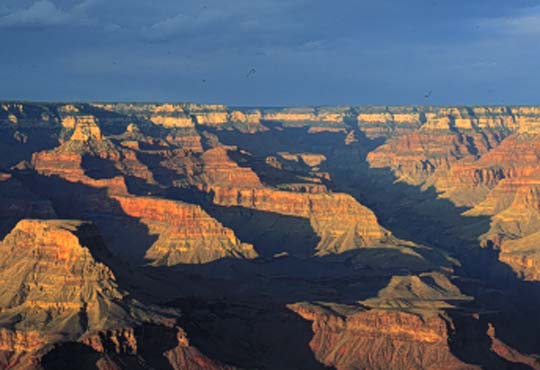Allopatric Speciation
 Photo by Mike Buchheit
Photo by Mike Buchheit
When the geography of an ecosystem is fragmented, whether through geological or human means, geographic isolation results.
Geographic isolation may result in adaptive radiation, which occurs if a species develops a fundamentally new and superior characteristic, enabling it to displace less well adapted species from a variety of habitats. It can also mean large scale extinctions of those species unable to adapt to the isolation. How formidable a geographical barrier is to an organism depends on that organisms ability to disperse. This depends on the mobility of animals or the dispersibility of spores, pollen, and seeds of plants (Campbell, 1994). This can be seen in the Grand Canyon, which is easily crossed by birds, but which is completely intraversible to most small mammals. In this way, populations of small rodents were isolated at the north and south ends of the canyon after its formation. The result is the same bird species throughout the entire canyon, but either side of the canyon has a unique species of rodent.
 Adaptive radiation, which is the evolution of many diversely adapted species from a common ancestor, also occurs through isolation. The results of this type of speciation can be seen on island chains, such as the galapagos. The species of the Galapagos descended from stragglers that flew, floated, or were blown over from the mainland.
Adaptive radiation, which is the evolution of many diversely adapted species from a common ancestor, also occurs through isolation. The results of this type of speciation can be seen on island chains, such as the galapagos. The species of the Galapagos descended from stragglers that flew, floated, or were blown over from the mainland.

A cactus finch; one of the many species of finch studied by Darwin on the Galapagos islands.
 Photo by Mike Buchheit
Photo by Mike Buchheit
 Photo by Mike Buchheit
Photo by Mike Buchheit
 Adaptive radiation, which is the evolution of many diversely adapted species from a common ancestor, also occurs through isolation. The results of this type of speciation can be seen on island chains, such as the galapagos. The species of the Galapagos descended from stragglers that flew, floated, or were blown over from the mainland.
Adaptive radiation, which is the evolution of many diversely adapted species from a common ancestor, also occurs through isolation. The results of this type of speciation can be seen on island chains, such as the galapagos. The species of the Galapagos descended from stragglers that flew, floated, or were blown over from the mainland.
